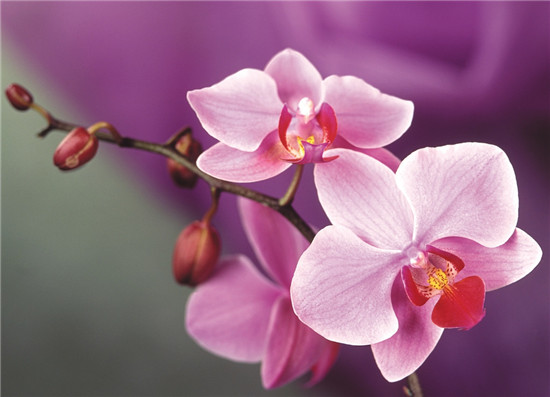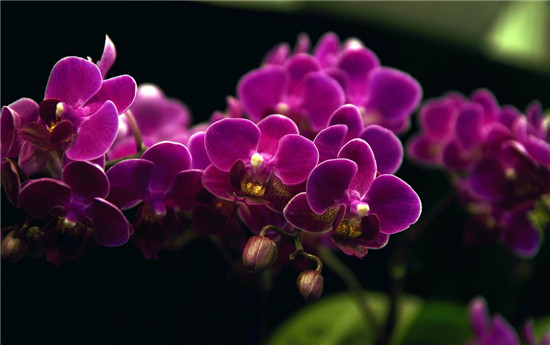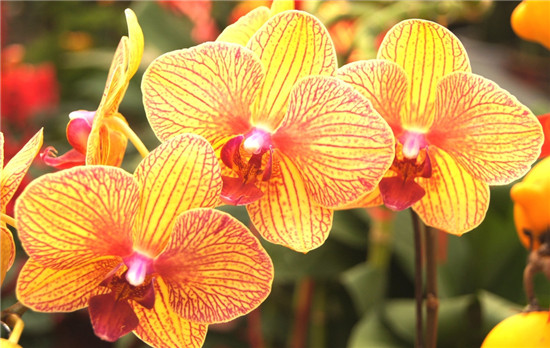[maintenance of Phalaenopsis] correct maintenance methods of Phalaenopsis
Phalaenopsis is a kind of plant suitable for indoor culture. Beginners should know which practices are not conducive to the growth of Phalaenopsis before breeding Phalaenopsis. Next, let's take a look at it.

The scientific name of Phalaenopsis is "like a butterfly orchid" in Greek. It can absorb nutrients in the air and survive and fall into the category of gas orchids. It can be said to be a large family of tropical orchids. Its plants are very peculiar, with neither stolons nor pseudobulbs. Each tree produces only a few broad leaves as thick as a spoon, stacked alternately on top of the base. The thick white air root is exposed around the leaves, and some cling to the outer wall of the flowerpot, which is full of natural wild interest. In the Spring Festival, a foot-long pedicel is drawn from the axils of the leaves and blossoms one by one. Each flower has 5 dusks, with lip flaps embedded in the middle. The flowers are bright, including pure white, goose yellow, tripping red, lilac, orange red and azure blue. Many varieties have both two-color or tricolor, some seem to be embroidered with stripes, and some seem to be sprayed with uniform color spots, with seven or eight flowers per branch, and more than twelve or three, which can be watched continuously for 60 or 70 days.
Phalaenopsis is a famous cut flower species, all belonging to more than 50 species. Phalaenopsis is a single-stem epiphytic orchid with short stems, large leaves, one to several flower stems, arched and large flowers, so named because the flowers are similar to butterflies. With beautiful flowers and gorgeous colors, it is a treasure of tropical orchids and has the reputation of "queen of orchid".

Butterfly orchid is graceful, elegant and varied, the flower is named after the butterfly, and is widely cultivated all over the world. Although it belongs to aerial orchid, it has no false bead stem, only a very short stem at the base. The leaves are wide and thick, long oval, up to more than 50 centimeters. Some varieties have beautiful light silver mottles on the leaves and purple underneath. Pedicel extracted from leaf axils, slightly curved, varying in length, several to hundreds of flowers, shaped like butterflies, sepals long oval, lip apex trifid, various colors, can blossom for more than a month, more cut flowers abroad, is a high-grade product in Magnolia. Most of the Phalaenopsis is tasteless, only a few have the smell, we call it the scented Phalaenopsis, this kind of Phalaenopsis is very rare, but many people smell it and say it is smelly, and some people have a headache when they work near the flower.
Family conservation of Phalaenopsis
Temperature family raise Phalaenopsis, first of all to ensure the temperature. Phalaenopsis is native to the tropics and likes the environment of high temperature and humidity. The lowest temperature during the growth period should be kept above 15 ℃. Phalaenopsis (especially Phalaenopsis) grows well when the daytime temperature is 27 ℃ and the night temperature is about 18 ℃. At the turn of autumn, winter and spring, and when the winter temperature is low, you should pay attention to warming rooms with heating equipment in winter. It is not difficult to reach this temperature, but be careful not to put the flowers directly on the radiator or too close to it. When the summer temperature is too high, need to cool down, and pay attention to ventilation, if the temperature is higher than 32 ℃, Phalaenopsis will usually enter a semi-dormant state, to avoid continuous high temperature. The flowering period is around the Spring Festival, and proper cooling can prolong the viewing time. The night temperature during flowering should be controlled between 13 ℃-16 ℃, but not less than 13 ℃.

Water Phalaenopsis belongs to epiphytic orchids, which are mostly born on tree trunks in the country of origin, and their roots are exposed to the air, which can absorb water from the moist air. When cultivated artificially, the root is buried in the cultivation substrate, such as too much watering, the ventilation of the substrate will become worse, the fleshy root will rot, and the leaves will turn yellow, which will lead to death in serious cases. According to the principle of watering, water should be watered again when the surface of the cultivation substrate becomes dry; generally, watering should be carried out on a sunny morning, and the water temperature should be close to room temperature. When the indoor air is dry, sprayers can be used to spray directly to the leaves, but be careful not to spray water spray on flowers during flowering.
Although Phalaenopsis prefers shade, it is still necessary to make the orchid plant accept part of the light, especially before and after flowering, the appropriate light can promote Phalaenopsis to bloom and make the flowers gorgeous and lasting, generally should be placed indoors where there is scattered light, do not let the sun shine directly; if placed on the indoor windowsill, cover part of the sun with a window screen.
In nutritional cultivation of Phalaenopsis, aquatic plants and moss are generally selected as the cultivation substrate. The principle of fertilization should be less fertilization and light fertilizer. In the normal growth period, 2000 times of special orchid fertilizer was applied to fertilize the roots, once every 2-3 weeks, depending on the growth. Before flowering, we can choose 15-30-15 water-soluble high-phosphate fertilizer 1000-2000 times liquid, about 10 days to spray once, and stop fertilization in flowering and low temperature seasons.

It takes about 2 years from seedling to flowering. The florescence is usually around the Spring Festival, and the viewing period can be as long as 2-3 months. When the flowers wither, the withered flowers should be cut off as soon as possible, which can reduce the consumption of nutrients. If the flower stem is cut off from the basal number of 4-5 nodes, it can blossom again after 2-3 months. However, this kind of plant nutrient consumption is too large, which is not conducive to the growth of the coming year. If you want to blossom again in the coming year, it is best to cut the flower stem from the base, and when the matrix ages, it should be replaced in time, otherwise the air permeability becomes worse, which will cause root rot, weaken plant growth and even die. Generally speaking, it is appropriate to change the basin in May when the new leaves grow.
Flowering maintenance of Phalaenopsis
In the indoor culture of Phalaenopsis, due to temperature and humidity and other factors, the leaves of the orchid plant only grow 1-2 in a year. Due to the limitation of temperature and humidity, Phalaenopsis grows singly on the top, and the flower bud grows between the two leaves. When the orchid plant grows flower bud, the indoor temperature is controlled at 18 to 20 degrees. After about 120 days of maintenance, Phalaenopsis will bloom. The flower stem to be born can be supported in advance in the flowerpot to prevent the flower stem from lodging. The flower stem needs to be fixed for many times in the process of growth to prevent the flower stem from breaking.
When each bud in the pot grows well, do not change the direction of the fragrance pot, lest the flowers of Phalaenopsis bloom uneven and affect the viewing. During the 4-month flowering period, keep the room ventilated and warm and keep the temperature between 15 and 18 degrees. The flowering period is around the Spring Festival, and proper cooling can prolong the viewing time. The night temperature during flowering should be controlled between 13 ℃-16 ℃, but not less than 13 ℃.
What should be paid attention to during flowering is gray spot, mainly due to not paying attention to the water droplets on the petals, or other diseases, which hinder the ornamental value of the flowers. Therefore, do not spray fat water on the petals.
These are all the contents of the correct conservation methods of Phalaenopsis that I have summarized for you. I hope this article can help you. Please continue to follow us.
It takes about 2 years from seedling to flowering. The florescence is usually around the Spring Festival, and the viewing period can be as long as 2-3 months. When the flowers wither, the withered flowers should be cut off as soon as possible, which can reduce the consumption of nutrients. If the flower stem is cut off from the basal number of 4-5 nodes, it can blossom again after 2-3 months. However, this kind of plant nutrient consumption is too large, which is not conducive to the growth of the coming year. If you want to blossom again in the coming year, it is best to cut the flower stem from the base, and when the matrix ages, it should be replaced in time, otherwise the air permeability becomes worse, which will cause root rot, weaken plant growth and even die. Generally speaking, it is appropriate to change the basin in May when the new leaves grow.
Flowering maintenance of Phalaenopsis
In the indoor culture of Phalaenopsis, due to temperature and humidity and other factors, the leaves of the orchid plant only grow 1-2 in a year. Due to the limitation of temperature and humidity, Phalaenopsis grows singly on the top, and the flower bud grows between the two leaves. When the orchid plant grows flower bud, the indoor temperature is controlled at 18 to 20 degrees. After about 120 days of maintenance, Phalaenopsis will bloom. The flower stem to be born can be supported in advance in the flowerpot to prevent the flower stem from lodging. The flower stem needs to be fixed for many times in the process of growth to prevent the flower stem from breaking.
When each bud in the pot grows well, do not change the direction of the fragrance pot, lest the flowers of Phalaenopsis bloom uneven and affect the viewing. During the 4-month flowering period, keep the room ventilated and warm and keep the temperature between 15 and 18 degrees. The flowering period is around the Spring Festival, and proper cooling can prolong the viewing time. The night temperature during flowering should be controlled between 13 ℃-16 ℃, but not less than 13 ℃.
What should be paid attention to during flowering is gray spot, mainly due to not paying attention to the water droplets on the petals, or other diseases, which hinder the ornamental value of the flowers. Therefore, do not spray fat water on the petals.
These are all the contents of the correct conservation methods of Phalaenopsis that I have summarized for you. I hope this article can help you. Please continue to follow us.
- Prev

Matters needing attention in potted cultivation of Anthurium andraeanum
Matters needing attention in potted cultivation of Anthurium andraeanum
- Next

Introduction of culture methods and matters needing attention of Anthurium andraeanum
Introduction of culture methods and matters needing attention of Anthurium andraeanum
Related
- Wuhan Hospital Iron Tree Blooming Result Was Instantly Frightened by the Gardener Master
- Which variety of camellia is the most fragrant and best? Which one do you like best?
- What is the small blue coat, the breeding methods and matters needing attention of the succulent plant
- Dormancy time and maintenance management of succulent plants during dormancy
- Minas succulent how to raise, Minas succulent plant pictures
- What are the varieties of winter succulent plants
- How to raise succulent plants in twelve rolls? let's take a look at some experience of breeding twelve rolls.
- Attention should be paid to water control for succulent plants during dormant period (winter and summer)
- Watering experience of twelve rolls of succulent plants
- Techniques for fertilizing succulent plants. An article will let you know how to fertilize succulent plants.

